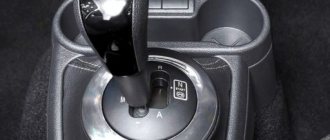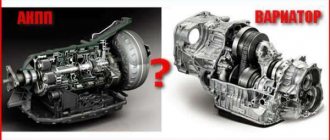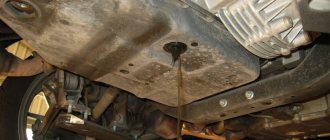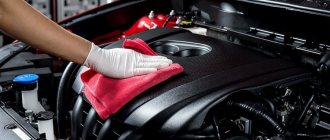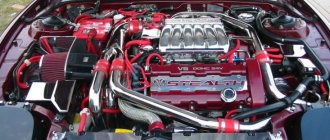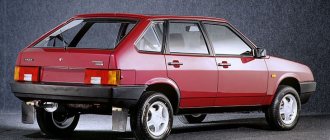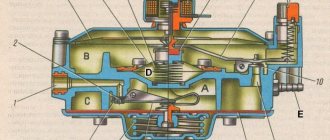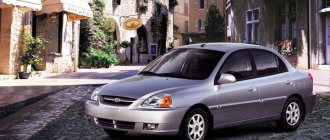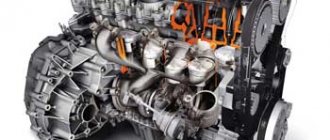Hello, I am glad to welcome you to the Question Auto website! Today's article will be a continuation of the series of articles about transmission. In it I will tell you what a dual clutch transmission is, how it works, and the pros and cons of dual clutch. Go!
Just recently, an automatic transmission was perceived as a know-how that had no future, as another useless invention “for the lazy.” And if in the West, fear was replaced by trust and recognition, then in our country this process dragged on, and even today on the Internet you can find an “Old Believer” who will tell many “horror stories” about the “automatic machine”, which will plunge even the most imperturbable motorists into horror. Fortunately, there are those who did not listen to stupid “fables”, took a risk and experienced all the delights of an automatic transmission from their own experience.
Time has passed, progress has dictated new technical requirements, and what recently seemed perfect today does not stand up to criticism. This happened with automatic transmissions; over time, classic automatics began to compete with more advanced transmissions, including a CVT and a dual-clutch automatic. By the way, if anyone is interested in whether a CVT or an automatic transmission is better, read this article.
After its appearance, the double clutch, like the automatic transmission, was criticized by skeptics, and some simply did not know what it was and “what it’s used with,” perhaps that’s why they were afraid to buy a car with such a gearbox. Today, this invention has millions of fans and boasts excellent characteristics, although, as always, there are those who still do not understand what a dual-clutch transmission is and how it differs from a regular “automatic”.
The main difference between a dual-clutch automatic transmission and a conventional automatic transmission is the smoothness of operation, which can only be provided by a CVT.
The history of the double clutch
The dual-clutch transmission, like many other inventions, came from sports, or rather from racing tracks. The first attempt to create a double-clutch transmission belongs to the Frenchman Adolphe Kegresse. Back in 1939, the world-famous designer tried to apply his development to the legendary Citroen Traction. But, unfortunately, the know-how remained a “paper project”, never reaching the assembly line. Later, in the 80s of the 19th century, Porsche engineers managed to create a gearbox capable of changing gears under load without releasing the gas. In racing, this invention was an incredible success, because even a fraction of a second, which is lost when slowing down while changing gears, can decide the outcome of the race. Simply put, turbo engines shifted into higher gears without changing the pressure in the turbine without loss of torque.
Advantages of dual clutch transmission / DSG
The main advantage of a dual clutch is that it provides the same driving performance as a manual transmission, with the convenience of an automatic transmission. However, the ability to perform near-instantaneous gear changes gives the dual clutch advantages over manuals and SMTs. Volkswagen's DSG takes about 8 milliseconds to upshift. Compare this to the SMT in the Ferrari Enzo, which requires 150 milliseconds to upshift. Instant gear changes mean faster acceleration; The Audi A3 does 0-100 in 6.9 seconds with a 6-speed manual transmission and 6.7 seconds with a 6-speed DSG.
Double clutch gearbox
This box is based on a double shaft, which is not present in the “mechanics”. In a conventional manual transmission, all gears are mounted on one shaft, while in a dual-clutch transmission, the first clutch transmits torque to the outer shaft, and the second to the inner. As a result, the first is responsible for even, and the second for odd, passes. In other words, it turns out that there are like two gearboxes in one housing, and they work alternately. The transmission control function is assigned to automation and hydraulics. A regular automatic transmission does not have a torque converter.
Topical: Which is better, automatic or manual? Let's choose the best option!
The most successful among dual-clutch gearboxes is the DSG (Direct Shift Gearbox - synchronized shift gearbox), built on a “dry” principle (the parts are not immersed in lubricant and cooling fluid). It is true that there are “wet” dual-clutch gearboxes, they are the opposite of the more successful “dry brothers” DSG.
Dual clutch transmission - what is it? Pros and cons of dual clutch
Hello, I am glad to welcome you to the Question Auto website!
Today's article will be a continuation of the series of articles about transmission. In it I will tell you what a dual clutch transmission is, how it works, and the pros and cons of dual clutch. Go! Just recently, an automatic transmission was perceived as a know-how that had no future, as another useless invention “for the lazy.” And if in the West fear was replaced by trust and recognition, then in our country this process dragged on, and even today on the Internet you can find an “Old Believer” who will tell many “horror stories” about the “automatic machine”, which will plunge even the most imperturbable motorists into horror. Fortunately, there are those who did not listen to stupid “fables”, took a risk and experienced all the delights of an automatic transmission from their own experience.
After its appearance, the double clutch, like the automatic transmission, was criticized by skeptics, and some simply did not know what it was and “what it was used with,” which may be why they were afraid to buy a car with such a gearbox. Today, this invention has millions of fans and boasts excellent characteristics, although, as always, there are those who still do not understand what a dual-clutch transmission is and how it differs from a regular “automatic”.
The main difference between a dual-clutch automatic transmission and a conventional automatic transmission is the smoothness of operation, which can only be provided by a CVT.
How does the dual clutch system work?
The operating principle of the double clutch is based on “anticipating” or pre-preparing the next gear, that is, when you set off in the first gear, the box has already begun to prepare the “second” gear. Shifting occurs instantly; when a gear shift occurs, the first clutch opens and the second clutch closes. The automatic system monitors the gas pedal and assumes that acceleration is occurring, and accordingly prepares the next gear. In general, the automation monitors not only the gas pedal; in addition to the accelerator, it takes into account: the rotation speed of the transmission shafts; wheel rotation speed, as well as the position of the gear lever. As a result, switching occurs at lightning speed, due to the fact that the clutches remain closed for only a few fractions of seconds, and the engine continues to remain connected to the drive wheels without losing torque.
A dual-clutch transmission is often called a “semi-automatic” because, at its core, it is a manual transmission without one pedal – the clutch pedal. Both the automatic transmission and the driver can change gears using the selector (gear shift lever), or using special steering wheel paddles.
Torque distribution diagram in a dual clutch box.
1 — clutch No. 1;
2 — clutch No. 2;
3 — input shaft of even gears;
4 — input shaft of odd gears;
5 — wheel drive;
6 - differential.
There are two types of clutches used in such transmissions: “wet” and “dry”. The first is a clutch with a pack of discs in oil. The electronics gives a command to the actuators, the hydraulic cylinder compresses the disks, and the clutch closes. To open, the pressure in the drive is reduced - and the diaphragm spring returns the hydraulic cylinder piston to its original position.
The “dry” clutch is similar to that on cars with a conventional manual transmission, only instead of one unit there are two. They are installed sequentially, each with its own drive, basket, and driven disk. Between the clutches there is a drive disk connected to the engine flywheel. The automation pulls one lever in turn, then the other, including the clutches of the first or second shafts - the basket presses the driven disk to the drive one and the torque from the engine flows into the box.
Operating principle of a dry clutch:
Pros of a dual clutch gearbox:
- Smooth gear shifting without any jerking;
- Economical. Compared to a conventional five-speed automatic, a dual-clutch transmission consumes 10% less fuel;
- Excellent dynamics, thanks to instant shifting without loss of power and torque;
- The ability to independently switch speeds without the participation of automation;
- The dual-clutch transmission is ideal for powerful engines of 200 horsepower or more.
Dual Clutch Transmission: Pros and Cons
A dual clutch transmission has a number of advantages and disadvantages. Let's look at some of them. If we talk about the advantages, then we can highlight:
- efficiency;
- smooth gear shifting;
- good dynamics;
- the ability to install a “wet” double clutch on cars with powerful engines.
We also recommend reading the article about the difference between the DSG gearbox and Powershift. From this article you will learn about the features and differences of these types of gearboxes, as well as which is better, DSG or Povershift.
Disadvantages of a dual clutch transmission:
- high technological complexity of the design;
- expensive repairs and maintenance;
- When driving dynamically with a “dry” clutch, extraneous noise and jerking may occur.
- reduced resource compared to other types of automatic transmission;
Disadvantages of a dual clutch gearbox
- The main disadvantage of the double clutch is the complexity of the design and all the elements that make up the box, as a result of which the cost of maintenance and repair work for a gearbox of this type is quite high;
- Due to the complexity of the design and relatively recent appearance, there are certain difficulties in finding high-quality service and repair services;
- In case of dynamic driving on a “dry” DSG, jerks, extraneous noises and dips may be observed.
The leader in the market of dual-clutch transmissions is the Volkswagen concern. Their units proved their reliability and reliability 13 years ago. Back in 2003, Volkswagen cars were equipped with six-speed DSG dual-clutch gearboxes. A few years later, even more advanced 8-speed DSG dual-clutch transmissions appeared.
A dual-clutch transmission is a kind of compromise that combines the advantages of a manual transmission (shift speed, efficiency) and an automatic transmission (comfort, smooth automatic shifting). Many leading automakers see the future in the DSG with a dual clutch, making this box a priority over the same CVT and automatic transmission.
When buying a car with a gearbox equipped with two clutches, you need to take into account the fact that these gearboxes are designed for 200-300 thousand km. Therefore, if the car has covered more than the specified mileage, but the owner swears that the gearbox and motor work like a clock, I still advise you to refuse such a purchase. It is unknown how long such a gearbox will last, and repairs, as I already said, will cost you a lot. As for new cars (up to 5 years old) equipped with a dual-clutch transmission, you can safely buy them and not be afraid that the DSG will not justify itself.
Dual clutch gearbox
A hybrid of automatic and manual transmissions has existed for a long time and has been successfully used in some car models, but like any device it can have its pros and cons.
Story
The idea of a box with two types of clutch belongs to Adolf Kegress, who hoped to test it on the Citroen Traction, but the economic crisis of the company slowed down this endeavor. For unknown reasons, a similar situation occurred with Audi and Porsche, but we managed to test double clutch in a racing car. And in 1986, the Porsche 962 with a hybrid transmission won the race in Monza.
The pioneer among conventional cars was the products of the Volkswagen concern.
Types of clutch
The clutch in a car can be wet or dry.
Wet clutch occurs due to the operation of a hydraulic pump and an oil reservoir with discs. But this option consumes more fuel and is quite cumbersome.
A dry clutch saves oil, but the clutch is not transmitted freely enough, and control is fraught with difficulties. It is difficult to say definitely which clutch is better; it all depends on the specific vehicle model and engine power.
How does a dual clutch transmission work?
A dual-clutch gearbox is a hybrid of an automatic and a manual, working alternately. In this version of the transmission, each of the boxes is responsible for its own functions: one for odd gears and reverse movement, and the second for everything else.
Gear changes are made automatically: starting in a low gear, as you gain speed, the system automatically prepares for second gear. The same happens with all other steps. As experts note, the hybrid requires only 8 milliseconds to change gears, and this is great progress.
When operating a dual-clutch transmission, the rotation speed of the shaft and all wheels increases.
Pros of double gearbox:
— no jerking when driving the car and a smooth ride
— gear shift options: automatic and independent
— increased dynamic characteristics
- economical fuel consumption
— when changing speeds, the connection between the gearbox and the engine is not interrupted, and the torque remains the same.
Disadvantages of double gearbox:
- high price of the device and its maintenance
- may fail in emergency situations
— lack of professionals to repair double-clutch transmissions.
But engineering does not stand still and over time all these shortcomings will be removed.
TOP 4 dual clutch gearboxes
BorgWarner is most often found on Volkswagen brand vehicles.
FiatPowertrain Technologies stands out with dry clutches with increased torque.
FEVGmbH puts emphasis on reducing the complexity of units and simplifying the process due to weight and dimensions.
Getrag produces the most environmentally friendly twin clutch transmissions.
Units from Ricardo, Graziano and Luk are also known on the world market.
In general, the dual clutch transmission is characterized by smooth gear changes and high dynamics.

